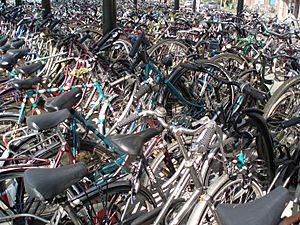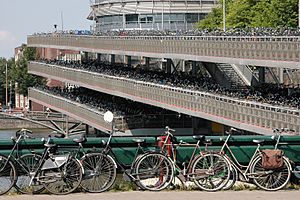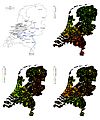Dutch people facts for kids

The Dutch are the people who live in the Netherlands, or those who originally come from there. Sometimes, the Netherlands is called Holland, but Holland is actually just a part of the Netherlands. Dutch culture and people are also found in other countries, like the United States, South Africa, Suriname, and Namibia.
Many famous inventors were Dutch. These include Hans Lipperhey and Zacharias Janssen, who helped invent the microscope and the telescope. The incubator was also invented by a Dutch person. The Netherlands is also known for its many famous painters, such as Rembrandt van Rijn, Vincent van Gogh, and Johannes Vermeer.
It can be tricky to define exactly who is "Dutch." You might think everyone living in the Netherlands is Dutch, but that's not always true. Many people living there were not born in the country. About 15.5 million people in the Netherlands have Dutch nationality. Around 1 million people living there do not. To make it even more interesting, people in other parts of the Kingdom of the Netherlands, like Aruba and Curaçao, also have Dutch nationality.
Contents
Dutch People Around the World
Around 30 million people with Dutch roots live all over the world. Here's a look at where many of them live:
| Country | Number of people |
|---|---|
| Netherlands | 16,587,551 |
| United States | 5,087,000 |
| South Africa | ~5,000,000 |
| Canada | 923,000 |
| Australia | 268,000 |
| Germany | 164,000 |
| Belgium | 123,454 |
| France | 83,000 |
| New Zealand | ~50,000 |
| Rest of the world | ~50,000 |
| Total | 33,892,000 |
How the Population Grew
Over the last 150 years, the Netherlands has seen its population grow quite fast compared to other countries in Europe. For example, Belgium had more people than the Netherlands in 1850, but by 2000, it had fewer. The population of the Netherlands grew from 3 million in 1850 to 5 million in 1900. It then reached 10 million in 1950 and 16 million in 2000. This shows a big increase in the number of people living in the country.
Life in the Netherlands Today
Today, Dutch society is very diverse, meaning it has many different cultures. About 20% of the people in the Netherlands have roots from other countries. Even some members of the Dutch Royal family have international backgrounds. This openness to different nationalities and religions started a long time ago, when the Republic of the Netherlands was founded in 1588. In the 17th century, it was common for people of different faiths, like Muslims, to live in cities like Amsterdam.
After World War II, the Netherlands invited many workers from countries like Turkey and Morocco to help rebuild the country. Many of these "guest workers" stayed, leading to large Turkish and Moroccan communities. People also came from Suriname and Indonesia, making Dutch society even more multicultural. Sometimes, different cultures living together can lead to challenges, but overall, the Netherlands values its diverse population.
The Dutch society is also known for its open-minded views.
The Netherlands is one of the most crowded countries in the world. Almost 16.5 million people live in this small country. Because of this, most Dutch people live in cities, not small villages. A city in the Netherlands usually has at least 25,000 people. About 8.7 million Dutch people live in "agglomerations," which are large urban areas connected to each other. This is about 54% of all Dutch people. Another 15% live in cities that are not part of these big connected areas. The remaining 30% live in smaller villages.
Getting Around
The Netherlands is a country where bicycles are used a lot! Almost 30% of all trips are made by bike. Because so many people cycle, hundreds of bicycle parking lots are built across the country. In Amsterdam, there's even a huge three-story parking lot just for bikes! Trains are also very popular for travel, unlike in some other countries like the United States. The biggest railway company, NS, carries 1.1 million travelers every day. That's about 7% of the entire Dutch population traveling by train each day!
Images for kids
-
Dutch people celebrating the liberation of the Netherlands at the end of World War II on 7 May 1945
-
The conversion of the Frankish king Clovis to Christianity was important in shaping the identity of the future Dutch people.
-
The Act of Abjuration, signed on 26 July 1581, was the formal declaration of independence of the Dutch Low Countries.
-
A typical November scene in the Dutch town Middelburg, Netherlands
-
A comparison of (identical) English, Dutch and German sentences, with IPA symbols added for pronunciation comparison
-
Dutch family in Java around 1903
-
Percentage of Dutch Americans per U.S. county according to the 2000 United States Census
See also
 In Spanish: Pueblo neerlandés para niños
In Spanish: Pueblo neerlandés para niños















